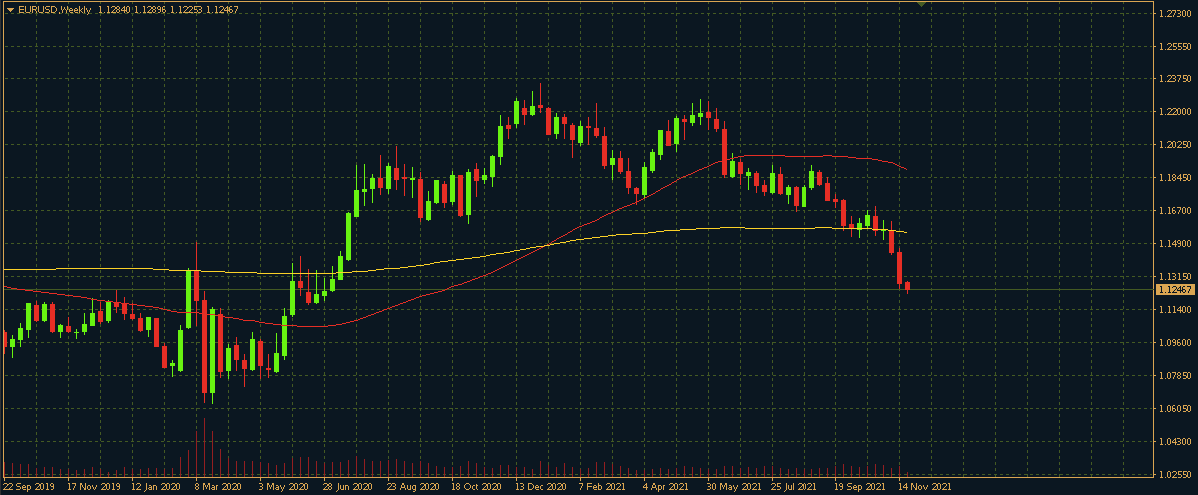
Gold 1792,325
|
EURUSD 1,1243
|
DJIA 35709
|
OIL.WTI 78,66
|
DAX 15979,95
|
|---|
The EUR/USD has fallen below 1.1300 for the first time in sixteen months and does not seem set to stop. How low can the euro go now and what is pushing it down?
EUR/USD

The US dollar is strengthening rapidly against a basket of currencies for the fifth week in a row. Risk aversion, expectations of a rate hike and rising inflation are all catalysts for growth.
This week the US currency is supported by the news that Jerome Powell is to remain in office for a second term as the Fed Chairman and hence, we can expect a tightening of the monetary policy in 2022.
The EUR remains under pressure against USD as Head of ECB Christine Lagarde said last week that the central bank will not rush to implement tough inflation-targeting measures. Therefore, do not count on a rate hike just yet.
This week the focus is on the threat of a slowdown in economic growth in European countries due to a new wave of pandemics and possible lockdowns.
The euro reacted on Tuesday with a local rise on the leading economic PMIs, which came in better than expected in October. However, the currency is unlikely to hold that position as it is already becoming clear that business activity will slow down in December.
Restrictions associated with a new pandemic wave will exacerbate an already difficult supply chain and inflation problems.
Against this background, how low can the EUR/USD fall? On the weekly chart the nearest support is looming around 1.1140. If it does not stop the fall, the pair may fly lower. The target is set to be 1.09-1.10. However, it is not worth of taking it so low, we should observe.
It is also worth mentioning that Wednesday will be a very saturated news flow, which might slow down or even speed up the USD growth against a basket of currencies, including the Euro. This is followed by a long Thanksgiving weekend in USA.
US dollar momentum might be boosted by consumer spending data, GDP report and publication of FOMC minutes from the last FOMC meeting. Not to mention the weekly U.S. initial jobless claims report, which probably isn’t much to look at after it came close to its pre-crisis level of around 260K.
The IFO index from Germany (an important leading index for evaluating the outlook for Europe’s biggest economy) and Thursday’s ECB meeting minutes will also give a local boost to the euro in the coming days.
The reaction of the dollar and the euro to this news is likely to determine whether the support at 1.1140 on EUR/USD will hold or whether the pair will continue to fall.
14.30 US GDP for the third quarter
20.00 Publication of FOMC minutes
Important Notes on This Publication:
The content of this publication is for general information purposes only. In this context, it is neither an individual investment recommendation or advice nor an offer to purchase or sell securities or other financial products. The content in question and all the information contained therein do not in any way replace individual investor- or investment-oriented advice. No reliable forecast or indication for the future is possible with respect to any presentation or information on the present or past performance of the relevant underlying assets. All information and data presented in this publication are based on reliable sources. However, Bernstein Bank does not guarantee that the information and data contained in this publication is up-to-date, correct and complete. Securities traded on the financial markets are subject to price fluctuations. A contract for difference (CFD) is also a financial instrument with leverage effect. Against this backdrop, CFD trading involves a high risk up to the point of total loss and may not be suitable for all investors. Therefore, make sure that you have fully understood all the correlating risks. If necessary, ask for independent advice.
